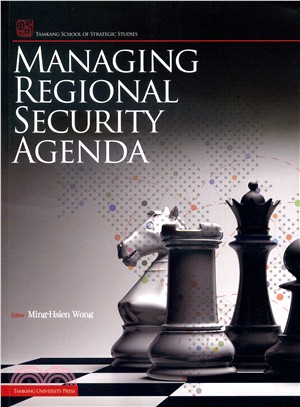Managing Regional Security Agenda
商品資訊
商品簡介
作者簡介
序
目次
相關商品
商品簡介
Introduction
Toward the end of his first term, President Barack Obama's election promise to reduce the American military presence in the Middle East and Afghanistan led to a general re-evaluation of priorities. What eventuated was a series of phrases to describe the new foreign policy posture. These included "rebalancing to Asia", the "pivot to Asia" and the "pivot to the Pacific".
The two principal drivers of the new posture were identified by then Secretary of State Hillary Clinton in a key November 2011 Foreign Policy article as winding down of the military engagements in Iraq and Afghanistan the "new global realities" of the Asia-Pacific Century. The juxtaposition of the two elements gave the American policy objectives a balance of power orientation with a military emphasis. The logic of "rebalancing" the balance of power in the Asia-Pacific in the wake of the growing ascendency of China is basic International Relations 101. The repositioning of US military assets into the Pacific has all the essential characteristics of classic geopolitical balance of power theory. A conservative American think tank phrased the pivot to Asia in just these terms in a recent assessment when it concluded, "the most significant problem for the United States in Asia today is China's
rising power, influence, and expectations of regional pre-eminence."
Toward the end of his first term, President Barack Obama's election promise to reduce the American military presence in the Middle East and Afghanistan led to a general re-evaluation of priorities. What eventuated was a series of phrases to describe the new foreign policy posture. These included "rebalancing to Asia", the "pivot to Asia" and the "pivot to the Pacific".
The two principal drivers of the new posture were identified by then Secretary of State Hillary Clinton in a key November 2011 Foreign Policy article as winding down of the military engagements in Iraq and Afghanistan the "new global realities" of the Asia-Pacific Century. The juxtaposition of the two elements gave the American policy objectives a balance of power orientation with a military emphasis. The logic of "rebalancing" the balance of power in the Asia-Pacific in the wake of the growing ascendency of China is basic International Relations 101. The repositioning of US military assets into the Pacific has all the essential characteristics of classic geopolitical balance of power theory. A conservative American think tank phrased the pivot to Asia in just these terms in a recent assessment when it concluded, "the most significant problem for the United States in Asia today is China's
rising power, influence, and expectations of regional pre-eminence."
作者簡介
翁明賢教授為德國科隆大學大學政治學系博士。經歷如下:淡江大學國際事務與戰略研究所所長、國家安全會議諮詢委員、台灣戰略研究學會理事長、國家安全會議張建邦諮詢委員辦公室專任研究員、美國國務院Fulbright Scholarship訪問學者。
專書篇章有<戰略研究的回顧與前瞻:再論淡江戰略學派之建構>,翁明賢主編,《當代戰略理論與實際:淡江戰略學派觀點》。台北:秀威資訊科技股份有限公司,2011年6月。<從敵手共生模式解析東亞戰略情勢>,翁明賢主編,《變遷中的東亞戰略情勢:淡江戰略學派觀點》。台北:秀威資訊科技股份有限公司,2011年6月。
序
Managing Regional Security Agenda(區域安全議程)計有十二篇論文,主要討論美國重返亞太戰略考量下,美中亞太地區的互動過程對於兩岸關係的影響,台灣面臨此種戰略態勢下>在兩岸區域與國際層面上如何因應的問題>上述兩本專書的寫作內容,不僅有其理論面向的推論過程,也配合實際現況加以分析,事實上也達到理論與實際配合的目的>是以,此兩本書的出版不僅有助於成為國際關係與戰略研究的入門書,更有助於相關單位戰略分析與研判的參考書籍>此外,本書的許多作者來自於日本’澳洲’義大利’紐西蘭等國家,透過本書的出版擴大淡江大學國際學術聲譽,更是本校致力於學術出版,推廣國際關係與戰略研究的具體呈現
目次
Content
A Pacific Islands View of the US Pivot to Asia: Can Washington
Develop an Effective Regional Strategy?
Richard Herr ................................................................... 1
The New U.S. Asia- Pacific Strategy and Regional Security
Kaocheng Wang ............................................................ 29
"Bilateralism or Multilateralism? Assessment of Taiwan
Status and Relations with South Pacific"
Juo-Yu Lin ..................................................................... 43
Abdication or Duel: Uncertain Interaction between US and
China in East Asia
Tung-Chieh Tsai ............................................................ 87
Taiwan’s Dilemma and Options in the South China Sea
Kuanghua Liu ............................................................. 109
China’s Rising Influence in the South Pacific
Paul D’Arcy ............................................................... 131
Taiwan’s Contribution to the Pacific Islands Security: From
the Perspective of the Pacific Plan
Ting‐Hui Lin ............................................................... 159
US Rebalancing Strategy toward the Asia-Pacific Region:
Implications for Taiwan
Li, Da-Jung .................................................................. 185
The US National Security Strategy in Obama’s Second Term:
A Niche for the Taiwanese Defense?
Jang-ruey Tzeng ......................................................... 215
The Return of the Learned Politician: Abe’s Security Strategy
Yoshifumi Nakai .......................................................... 237
The Preliminary of the Relationship between Economic
Growth and Military expenditure: The Case Study of the
People’s Republic of China (1990-2010)
Xiu-Heng Ye ................................................................ 263
Swimming with Dragons: Cross-Strait Waves in the South Pacific
Fabrizio Bozzato ......................................................... 319
A Pacific Islands View of the US Pivot to Asia: Can Washington
Develop an Effective Regional Strategy?
Richard Herr ................................................................... 1
The New U.S. Asia- Pacific Strategy and Regional Security
Kaocheng Wang ............................................................ 29
"Bilateralism or Multilateralism? Assessment of Taiwan
Status and Relations with South Pacific"
Juo-Yu Lin ..................................................................... 43
Abdication or Duel: Uncertain Interaction between US and
China in East Asia
Tung-Chieh Tsai ............................................................ 87
Taiwan’s Dilemma and Options in the South China Sea
Kuanghua Liu ............................................................. 109
China’s Rising Influence in the South Pacific
Paul D’Arcy ............................................................... 131
Taiwan’s Contribution to the Pacific Islands Security: From
the Perspective of the Pacific Plan
Ting‐Hui Lin ............................................................... 159
US Rebalancing Strategy toward the Asia-Pacific Region:
Implications for Taiwan
Li, Da-Jung .................................................................. 185
The US National Security Strategy in Obama’s Second Term:
A Niche for the Taiwanese Defense?
Jang-ruey Tzeng ......................................................... 215
The Return of the Learned Politician: Abe’s Security Strategy
Yoshifumi Nakai .......................................................... 237
The Preliminary of the Relationship between Economic
Growth and Military expenditure: The Case Study of the
People’s Republic of China (1990-2010)
Xiu-Heng Ye ................................................................ 263
Swimming with Dragons: Cross-Strait Waves in the South Pacific
Fabrizio Bozzato ......................................................... 319
主題書展
更多
主題書展
更多書展今日66折
您曾經瀏覽過的商品
購物須知
為了保護您的權益,「三民網路書店」提供會員七日商品鑑賞期(收到商品為起始日)。
若要辦理退貨,請在商品鑑賞期內寄回,且商品必須是全新狀態與完整包裝(商品、附件、發票、隨貨贈品等)否則恕不接受退貨。
































